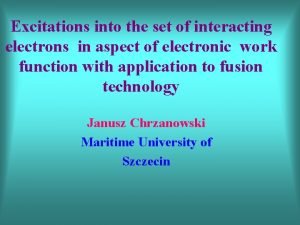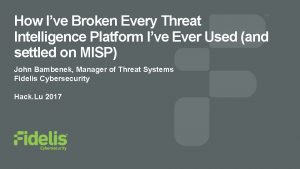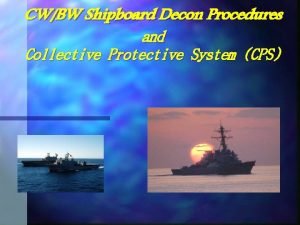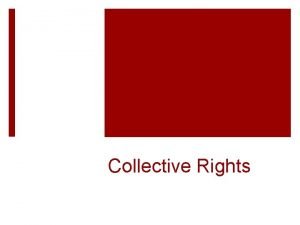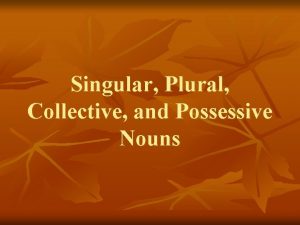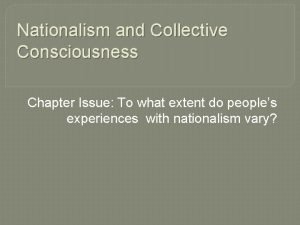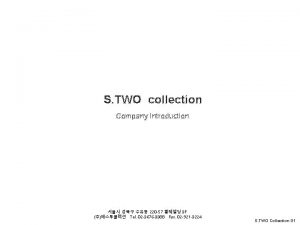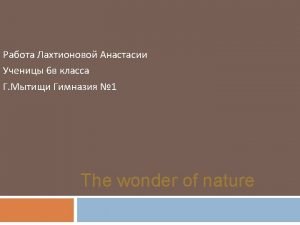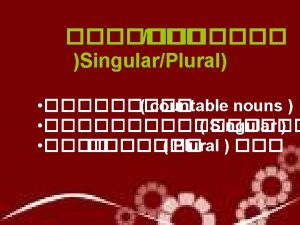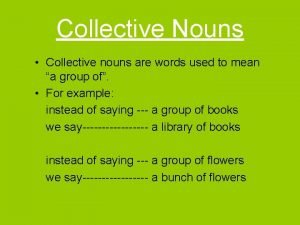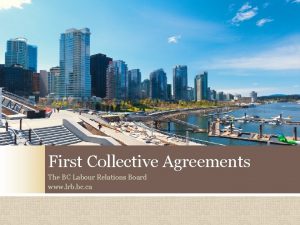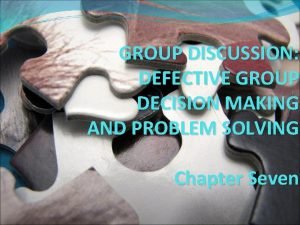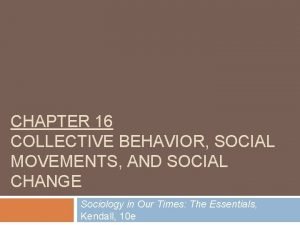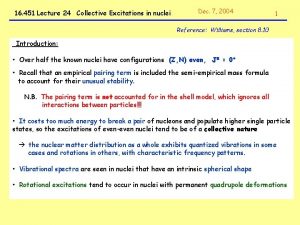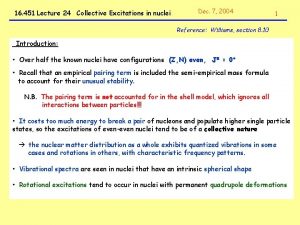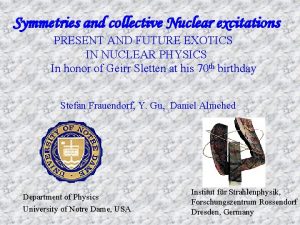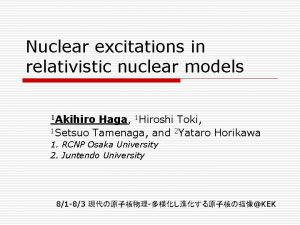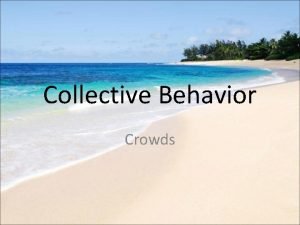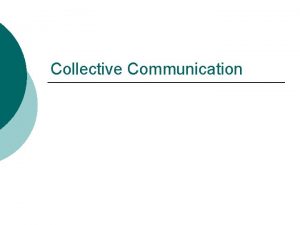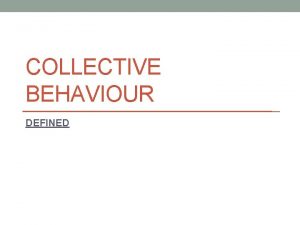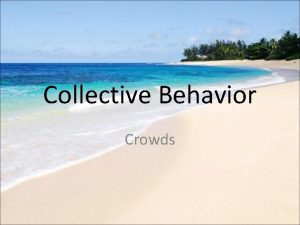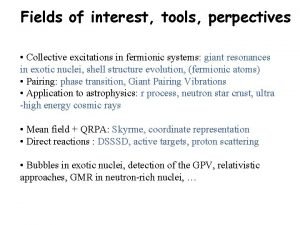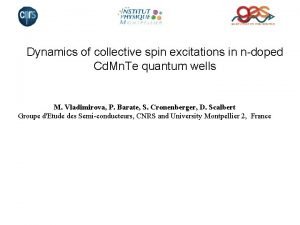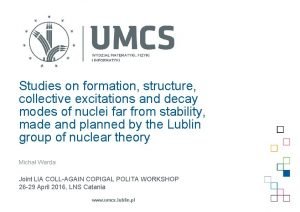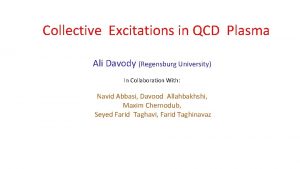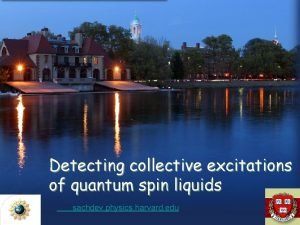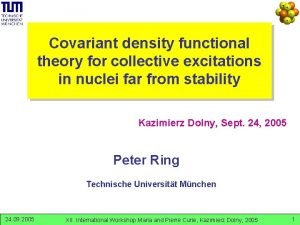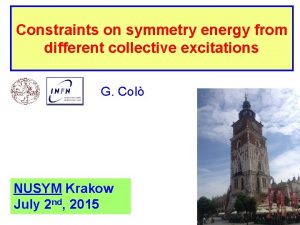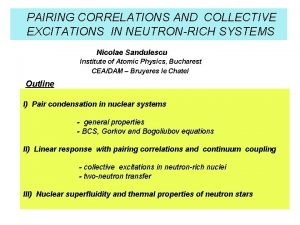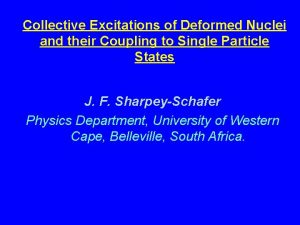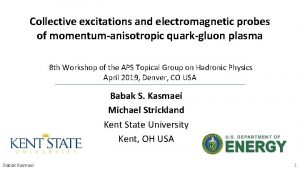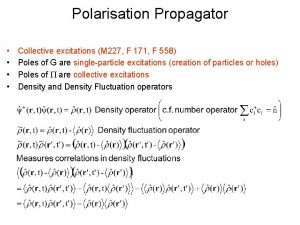16 451 Lecture 24 Collective Nuclear Excitations 1
























- Slides: 24

16. 451 Lecture 24: Collective Nuclear Excitations 1 1. Oscillations about spherical equilibrium with characteristic Y ( , ) pattern: - occur in even-even nuclei (J = 0+ ground states) - energy is quantized: En = n ħ where is the characteristic frequency - shape and frequency depend on the multipole order - angular momentum and parity are given by: J = , = (-1) - since excitations are Bosons (integer spin), allowed combinations must have symmetric total wavefunctions. . . Lowest value of that is observed is the “giant dipole resonance”, = 1: (neutrons and protons oscillate out of phase – CM remains fixed) protons = 1 neutrons time

“Giant Dipole Resonance” in Nuclei: J = 1 - “GDR” 2 • characteristic feature that can be seen in all nuclei • very short-lived state at high excitation • E 1 = ħ 1 78 A-1/3 Me. V (example below: 197 Au, E = 15 Me. V) • 6 Me. V (common feature) 10 -22 s • classical analog is an oscillating electric dipole moment – can decay via E 1 radiation pattern (signature) Electric dipole radiation pattern: Griffiths, Intro. to Electodynamics: z

Quadrupole oscillations occur at lower energy: J = 2+ = 2 3 time • typically, ħ 2 ~ 1 Me. V in a variety of even-even nuclei • excitation energy is low, so can expect to see up to several “quadrupole phonons” in the spectrum energy • Boson excitations, so require a symmetric wave function under exchange of “particle” (phonon) labels this restricts the total J , 2 ħ 1 ħ 0 e. g. for two phonons: 0+ , 2 + , 4 + 2+ 0+ Model spectrum

Example of vibrational excitations: (Krane Fig. 5. 19) 4 3 - state? 3ħ 2 multiple = 2 phonon states, ideally degenerate n = 2, J = 0+, 2+, 4+ 2ħ 2 (characteristic decay patterns: gamma-rays emitted with “E 2” angular distributions, like a quadrupole antenna) ħ 2 n=1, = 2, 2+ phonon (E-E ground state) E (Me. V) contrast, adding one neutron: 0. 29 11/2 0. 21 3/2 0 ½+ - +

The 3 - state is an octupole phonon, = 3: = 3 5 time • J = 3 • ħ 3 ~ (2 -3) ħ 2 ~ 2 – 3 Me. V • typically only see one octupole phonon per spectrum Summary: • low lying excitations in even-even spherical nuclei have the same characteristic pattern up to a few Me. V in excitation energy: 0+ (gs), 2+ (quadrupole phonon), (0+, 2+, 4+) (two phonons), 3 - (octupole)

2. Quantized Rotations in deformed nuclei: 6 Classical rotating object: dm Replace L with rotational angular momentum J: moment of inertia sets the scale of the energy level pattern allowed J determine a characteristic spacing pattern J is quantized; “rotational bands” are spectra characterized by a given value of the moment of inertia, I, and a series of energy levels with J = 1 or 2: • even-even nucleus: J = (0, 2, 4, 6, 8, 10. . ) = + • odd-even deformed nucleus: J = ½ integer, J = 1 within a “band”

Example: 7 176 Yb Quantized energy states of a rotating football! J Note -- larger I means smaller energy level spacing! note: rotations around the symmetry axis are indistinguishable; rotational angular momentum must be perpendicular to the symmetry axis.

The moment of inertia gives a measure of the nuclear shape: parameterize the shape, quadrupole moment and moment of inertia assuming constant density football shape: z 8 R( ) If the nucleus rotates like a solid: (rigid body model): If the nucleus rotates like a liquid drop: (rotating fluid model) reality is somewhere in between. . .

Evidence of “quasi-fluid” behaviour for rotating nuclei: 9 spectral analysis: a plot of E vs J(J+1) should give a straight line with slope ħ 2/2 I • confirmed for 174 Hf • but for 158 Er, the slope decreases (moment of inertia increases) with increasing J. . . J J(J+1) Like a rotating fluid: “centrifugal stretching” along the symmetry axis occurs for larger angular momentum!

Quadrupole moments and types of excitations across the nuclear chart: lighter nuclei: small Q. E-E nuclei have vibrational states 10 Rare earth region: ~ 0. 2 – 0. 3, rotational spectra for E-E single particle states in a deformed potential for O-E Closed shell nuclei: spherical; O-E nuclei near closed shells are good “Shell Model” candidates. . .

11 And FINALLY, a quick word about SNO: Sudbury Neutrino Observatory: http: //www. sno. phy. queensu. ca/ • SNO was built over a decade starting in the late 1980’s at a cost of ~ $100 M to solve a long-standing problem in the observed deficit of neutrinos coming from the sun. • A classic radiochemical experiment by Ray Davis et al carried out in a gold mine in South Dakota using the reaction: ? Earth had reproducibly detected only about 1/3 of the expected number of neutrinos of solar origin. What was wrong? ? ? Prior to SNO, several other solar neutrino experiments were constructed and in operation world wide, e. g. the Kamiokande detector in Japan, SAGE and GALLEX detectors in Europe. . . all had slightly different energy sensitivities and operated using different reactions to detect the neutrinos, but all found a discrepancy in the solar flux!

Calculated neutrino flux from fusion reactions in the sun, J. Bahcall et. al Energy thresholds of various detectors are shown: 12

All detectors, including SNO, show a deficit of electron neutrinos from the sun: 13

SNO – a unique D 2 O Cerenkov detector that can “see” all neutrino types 14 4700’ underground in the Creighton nickel mine in Sudbury, Canada, to suppress background from cosmic ray muons, etc: acrylic vessel holds 1000 tonnes of heavy water, D 2 O that makes an ideal detector for neutrinos. 20” diameter photomultiplier tubes looking inward detect Cerenkov light when a neutrino interacts in the water Neutrino candidate event: Cerenkov “ring” on one side of the detector with nothing entering from the other side.

Neutrino detection mechanisms in heavy water: 1. “Charged current” mechanism: (electron produces Cerenkov light in the water tank) 2. “Neutral current” mechanism: resulting neutron can be captured in a salt solution, and resulting -rays, which hit electrons in the water, again produce Cerenkov light that is picked up in the PMT’s Ratio of 1 : 2 gives the ratio of electron-type to total neutrinos from the sun! 15

SNO published results: http: //www. sno. phy. queensu. ca/sno/publications. html 16 electron-neutrinos only all neutrino types Ratio: Significance of the SNO result: first experiment to “see what happened” by measuring all neutrino types Interpretation: • the total number of neutrinos is consistent with expectations from the solar model. • only electron-type neutrinos are produced in solar fusion reactions • 2/3 of these must be turning into other neutrino types ( , ) before reaching earth! Unavoidable conclusion: neutrinos must have a small but finite rest mass! (next question: how big is it? )

Neutrino masses and mixing: (see, e. g. http: //www. sns. ias. edu/~jnb/ ) 17 The theory of neutrino mixing gets complicated very quickly, but in a nutshell, the observation of “neutrino oscillations” sets limits on the mass-difference m 2 and the mixing angle , e. g. for only two neutrino types, one could write: Then as time evolves, with the masses of 1 and 2 being different, the observed “neutrino state” will be a different linear combination of 1 and 2 that depends on the parameters m 2 and sin 2 . Combined data from all experiments can be used to place limits on the mixing parameters. . so far, the favoured situation looks like this:

The SNO result is an incredible achievement for physics and Canada 18 http: //www. nserc. ca/news/2003/p 031124. htm It wasn’t easy! For a few years, the subatomic research community almost went broke trying to pay for SNO. . but it was worth it! SAP visits SNO as chair of NSERC GSC, 1997 – borrows $3 M from NSERC to pay for construction cost overrun. .

Graduate Studies in Physics & Astronomy think about it!!!! • Astronomy and Astrophysics • Atomic and Molecular Physics • Condensed Matter and Materials Physics • Mass Spectrometry of Large Biomolecules • Precision Atomic Mass Determinations • Mathematical Physics • Medical Physics • Subatomic Physics Financial Support: All students accepted into the Department of Physics and Astronomy receive financial support through scholarships, teaching assistantships and/or research stipends. For more information, or to receive an application form, contact us by email at physics@umanitoba. ca, or visit our web site at www. physics. umanitoba. ca

Canadian Penning Trap Mass Spectrometer at Argonne National Laboratory (K. S. Sharma) 1 m Schematic view of the CPT spectrometer and related apparatus. Our program of measurements is aimed at: Øimproving our knowledge of nuclear masses among nuclei in exotic regions. The Canadian Penning Trap (CPT) mass spectrometer is installed at the ATLAS facility of the Argonne National Laboratory. Short-lived, unstable nuclides are produced when beams of heavy ions from the ATLAS facility strike a target. The products recoil out of the target and are separated from unwanted contaminations with a gas-filled, split-pole, magnetic separator. Ions of the nuclide selected for study are stopped in helium gas and accumulated in a novel linear RFQ-trap, called the gas cooler. The accumulated ions are transferred to the CPT spectrometer where their masses are determined to an accuracy approaching 1 ppb. With this apparatus we can carry out measurements on a wide variety of nuclides with half-lives greater that 30 ms. To enquire about opportunities for summer research assistants, graduate students and post-doctoral fellows please contact: Øobtaining precise mass data that allows tests of the Standard Model and fundamental symmetries. Dr. Kumar S. Sharma Department of Physics and Astronomy Øproviding valuable input to astrophysical theories University of Manitoba on nucleosynthesis and allow critical tests of the Winnipeg, Manitoba, Canada R 3 T 2 N 2 theories of nuclear masses. sharma@physics. umanitoba. ca

Fundamental Symmetries and Nucleon Structure (J. Birchall, W. R. Falk, S. A. Page, W. T. H. van Oers) The subatomic physics group has a vigorous research program based at leading accelerator facilities. We are interested in fundamental symmetry properties of the weak and strong interactions, and how these affect nucleon structure. At Jefferson Laboratory (USA), we play a leading role in two major experiments that involve measurements of tiny parity- (mirror symmetry) violating asymmetries in electron-proton scattering: The `G 0’ experiment, currently underway, will measure parity-violating asymmetries at a range of momentum transfers to map out the role that strange quarks play in the proton’s electromagnetic structure. The `Qweak’ experiment will measure the forward scattering asymmetry at very small momentum transfer as a precision test of the electroweak mixing angle sin 2 W -- any deviation from the Standard Model prediction is a sensitive probe of additional force carriers and thus indicates new physics. At Los Alamos National Laboratory (USA), we make use of the world’s highest intensity pulsed cold neutron beam to make a definitive measurement of parity violation in the fundamental process n+p d+ , which will settle a long standing controversy regarding the pion exchange component of the weak nuclear force. We have openings for graduate students as well as summer undergraduate research projects! Students have the opportunity to travel and interact with top ranking scientists from around the world through participation in these leading international collaborations. Contact Dr. S. Page (spage@cc. umanitoba. ca) for more information!

The Qweak Experiment at Jefferson Lab: A Search for Physics Beyond the Standard Model (J. Birchall, W. . R. Falk, S. A. Page, W. T. H. van Oers) A major new initiative, the `Qweak’ experiment, is under rapid development at Jefferson Laboratory. Qweak will measure the proton’s weak charge -- a basic property, like its electric charge and mass, which determines how a proton responds to the weak interaction. We will infer the proton’s weak charge from measurements of parity violating electron-proton scattering at very small momentum transfer; electrons scattered at small angles will be deflected into very sensitive detectors by a large magnetic spectrometer that is being constructed by our group. By providing a first precision measurement of this important property, the Qweak experiment will also provide a stringent test of the Standard Model that describes the fundamental interactions on a microscopic scale. Our new experiment has the potential to make the first really high precision test of the running of the weak coupling constant to low energy. If a discrepancy with theory is found, Qweak could be one of the first experiments to provide convincing evidence that there additional elementary force carriers beyond what we know today. Theorists have shown that the Qweak experiment should be able to infer the possible existence of hitherto unobserved force carriers up to the impressively high mass scale of 4. 7 Te. V, which is currently beyond the reach of direct experimental tests. Positions are currently available for graduate students who would to participate in this exciting endeavour. Contact: Dr. S. Page: spage@cc. umanitoba. ca

Fundamental symmetries with trapped ultra-cold atoms and ions (G. Gwinner) We are a new group at the U. of Manitoba, establishing a research programme in lasercooling and trapping of francium at the ISAC radioactive beam facility at TRIUMF, Vancouver Goal: study electroweak interaction and search for physics beyond the Standard Model by performing very precise laser-spectroscopic experiments Schematic of a magneto-optic trap (MOT) to capture Fr atoms produced in a nuclear reaction at ISAC into a millimeter-sized ball of 107 atoms cooled to 100 micro-Kelvin. at low energies, atomic parity nonconservation experiments are unique in probing the Standard Model The squared Weinberg-angle, a key observable in electroweak physics, as a function of the interaction energy We are looking for graduate students interested in this combination of fundamental physics and table-top laser spectroscopy contact: Gerald Gwinner, Dept. of Physics, Univ. of Manitoba, (204) 474 -9856, gwinner@physics. umanitoba. ca, www. physics. umanitoba. ca/people/faculty/gwinner. html

The TITAN ion trap facility at ISAC (G. Gwinner) We collaborate with a group at TRIUMF (J. Dilling et al. ) on the realization of an ion trap system mounted on-line at the TRIUMF ISAC radioactive beam facility, which will be unique in the world. Physics goals: measure extremely precisely masses of unstable nuclei -- this information is crucial to our understanding of stellar nucleosynthesis (nuclear astrophysics) and weak interaction experiments. projects: 1. a electron-cooler trap to precool highly-charged ions before injection into the precision trap 2. design of a Penning ion trap to perform measurements of the electron’s bound-state gfactor to test QED and nuclear structure contact: Gerald Gwinner, Dept. of Physics, Univ. of Manitoba, (204) 474 -9856, gwinner@physics. umanitoba. ca, www. physics. umanitoba. ca/people/faculty/gwinner. html
 Threshold frequency
Threshold frequency Fisión nuclear vs fision nuclear
Fisión nuclear vs fision nuclear Lesson 15 nuclear quest nuclear reactions
Lesson 15 nuclear quest nuclear reactions 01:640:244 lecture notes - lecture 15: plat, idah, farad
01:640:244 lecture notes - lecture 15: plat, idah, farad Collective intelligence framework
Collective intelligence framework Strikes unions and collective bargaining
Strikes unions and collective bargaining Site:slidetodoc.com
Site:slidetodoc.com Opseu collective agreement salary chart
Opseu collective agreement salary chart Collective protection system
Collective protection system Collective intelligence example
Collective intelligence example Canadian collective rights
Canadian collective rights Role of collective bargaining
Role of collective bargaining Collective nouns plural or singular
Collective nouns plural or singular Canadian collective consciousness
Canadian collective consciousness Collation collective
Collation collective Checklist method in entrepreneurship
Checklist method in entrepreneurship Amuse collective agreement
Amuse collective agreement Niagara falls is the collective name for three waterfalls
Niagara falls is the collective name for three waterfalls Examples of collective impact
Examples of collective impact Echoes singular
Echoes singular Noun paragraph example
Noun paragraph example Money madness poem ppt
Money madness poem ppt Bc labour relations board
Bc labour relations board Combating groupthink
Combating groupthink What is collective behaviour in sociology
What is collective behaviour in sociology
